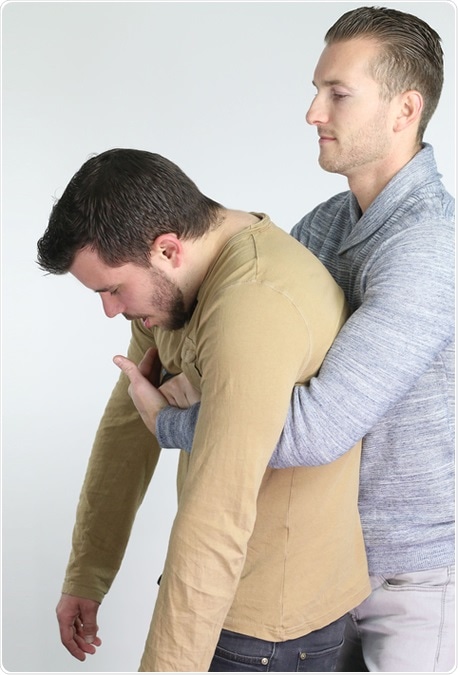Heimlich Maneuver / Abdominal Thrusts?
Heimlich maneuver or abdominal thrusts is a technique used to relieve choking victims. The aim of the procedure is to dislodge a foreign object that is blocking the airway of the victim. It is named after the physician Henry J Heimlich who invented the technique in the 1970s.

How is it Performed?
To perform the maneuver, make a fist with your dominant hand and keep the fist’s thumb side between the belly button and sternum of the victim. Grab the fist with the other hand and give strong inward and upward thrusts of increasing pressure till the blockage is cleared.
Mild and Severe Choking
When a person is choking, his airway is partially or fully blocked, interfering with his breathing. Choking can be mild or severe. In case of mild choking, encourage the person to cough. If the airway is partially blocked, the victim can usually speak, cough, or even breathe to an extent and hence will be able to handle the situation themselves and clear the blockage.
In case of a child above 1 year or an adult with mild choking, encourage the victim to try coughing and clear the blockage, ask them to try to spit the object out once it is in their mouth. Avoid putting your fingers in their mouth in an attempt to help them as there is a risk of accidental biting. When coughing doesn't work, abdominal thrusts should be administered.
In case of severe choking, abdominal thrusts need to be performed immediately. During severe choking the victims won’t be able to speak or cough as the airways are fully blocked. They may eventually become unconscious and/ or die in the absence of intervention.
Abdominal Thrusts – Standing Position
- Standing behind the choking person, help them to lean forward by keeping your arms around the victim’s waist.
- Place your clenched fist above the belly button of the person.
- Pull the fist inward and outward strongly using the other hand.
- Repeat this step up to five times.
Abdominal Thrusts – Lying Down Position
Heimlich also developed an alternate way to perform the maneuver in the lying-down position keeping in mind situations where a huge built person is choking and needs to be rescued by a small built person or a child or when the victim is lying unconscious.
In such situations, the rescuer should follow these steps:
- Facing the victim who is lying on his or her back, kneel down near his thighs
- Place the heel of one hand between the belly button and rib cage of the victim
- Put your other hand, palm downwards on top of the former
- Press down on the heel with inward and upward movements till blockage clears
If the blockage is not cleared even after performing abdominal thrusts, take the person to the ER without wasting any more time. But keep performing back blows and abdominal thrusts till the person receives medical attention. If the victim stops breathing or faints, perform CPR and chest compressions.
Caution
Abdominal thrusts should never be performed in infants under 1 year or in pregnant women. For choking infants, back slaps may be helpful, while chest compressions are recommended for pregnant women who are choking.
Even though it is a life-saving procedure, it involves heavy blows and may lead to serious injuries at times. Once this procedure is successfully done, the victim should always be seen by a doctor to assess any internal damage due to the thrusts. Choking victims also need medical attention if coughing persists or they have a feeling that something is still inside their throats.
References
- https://www.nlm.nih.gov/medlineplus/ency/article/000047.htm
- http://www.nhs.uk/chq/Pages/2301.aspx
- http://www.thespec.com/living-story/6703857-you-can-save-a-life-how-to-perform-the-heimlich-manoeuvre/
Further Reading
- All Heimlich Maneuver Content
Last Updated: Feb 26, 2019

Written by
Susha Cheriyedath
Susha has a Bachelor of Science (B.Sc.) degree in Chemistry and Master of Science (M.Sc) degree in Biochemistry from the University of Calicut, India. She always had a keen interest in medical and health science. As part of her masters degree, she specialized in Biochemistry, with an emphasis on Microbiology, Physiology, Biotechnology, and Nutrition. In her spare time, she loves to cook up a storm in the kitchen with her super-messy baking experiments.
Source: Read Full Article
